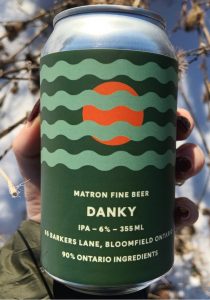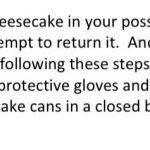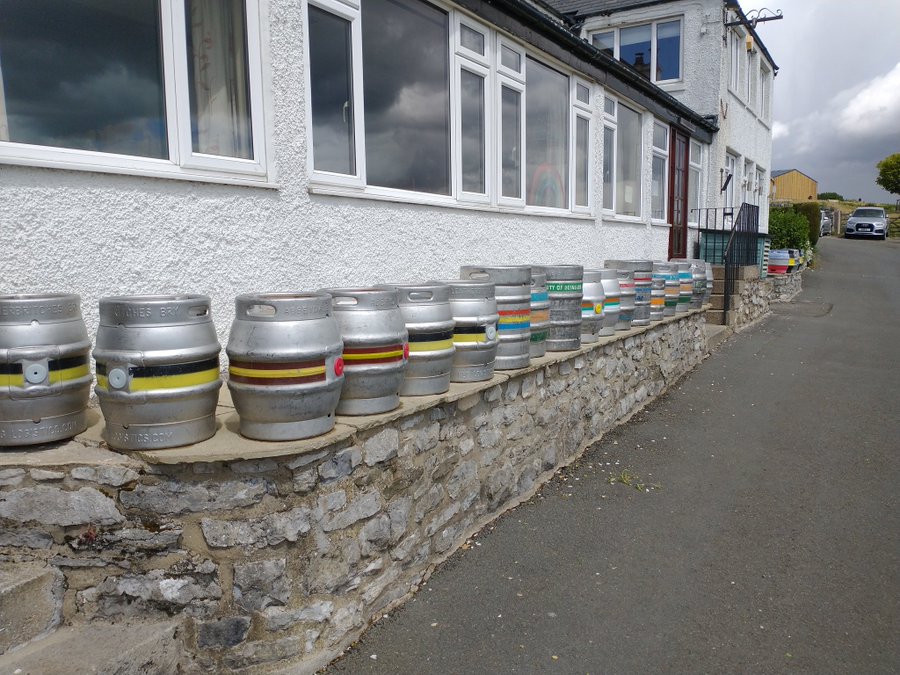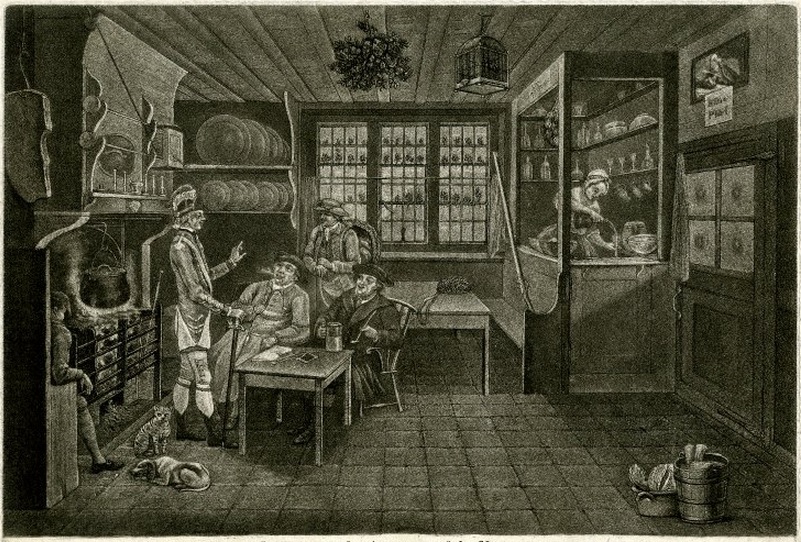 The blahs. I have never liked February all that much but in this year of the plague I’ve actually come to appreciate it. The the lengthening days compare well to what’s been out the window for the previous couple of months. So there. But there is a blah nonetheless. Not much vibrancy in the world of beer writing. That’s what I am talking about. It’s all a bit due to other themes both worthy and banal being layered over, sure, but even with that… there is blah.
The blahs. I have never liked February all that much but in this year of the plague I’ve actually come to appreciate it. The the lengthening days compare well to what’s been out the window for the previous couple of months. So there. But there is a blah nonetheless. Not much vibrancy in the world of beer writing. That’s what I am talking about. It’s all a bit due to other themes both worthy and banal being layered over, sure, but even with that… there is blah.
Not as blah as that image up there of a pub lovingly taken and posted by ATJ. I love it because it is so horrible. It could be called The Blah Pub unless it was 1994 when it would be Pub Blah. The image of the scary lad drinking painted on the façade in the upper right is particularly horrible. Who thought that would help? Anyway, it reminds us all that ugly is not necessarily all about the ugly. Therefore… I start this week in an effort to disprove my own blahlological observations with a study of “blah / not blah.”
Not blah? Perhaps this tweet, as it is at least taking a stance:
Beer should be like wine. Only named after the region or the hops used. Styles are just made up.
Except beer isn’t really regional and hops only define certain sorts of beer. So.. a bit blah but assertion saves it somewhat. And “style” sucks, we all know that now.
Elsewhere,  Rob MacKay, Creative Director at Glasgow’s Drygate Brewing Co., created and shared what he calls Beer Care Instructions:
Rob MacKay, Creative Director at Glasgow’s Drygate Brewing Co., created and shared what he calls Beer Care Instructions:
“…a handy set of standardised icons, which can be applied to beer in the same way that the global standards for laundry care are…”
I like this a lot and it is definitely not blah as it is both thoughtful and somewhat cheerily useless. Yet serves as an alternative construct to all the failures laying about our ankles. One that I see is missing is “tastes like beer and not a fruit salad that’s been left out in the sunlight.” Still, very not blah.
History. Not blah is the news out of Egypt that a 5,000 year old mass production brewing facility has been uncovered, as the BBC reports:
The brewery consisted of eight large areas, each 20m (65ft) long and each containing about 40 earthenware pots arranged in two rows, according to the secretary general of Egypt’s Supreme Council of Antiquities, Mostafa Waziry.
 Seven years ago, I posted about a visit to the Royal Ontario Museum where I saw an original display showing brewing in Ancient Egypt. Perhaps this group of people represented one of these eight areas or even just a portion of it. Nope. Not that. A household brewery in Thebes. Never mind. Update: the site has been known for over a century. Q: if Hornsey knew that Egypt was fuelled by beer consumed throughout society, how is a 22,000 litre facility a surprise? At a max a gallon a day consumption, this facility supplies 6,000 people.
Seven years ago, I posted about a visit to the Royal Ontario Museum where I saw an original display showing brewing in Ancient Egypt. Perhaps this group of people represented one of these eight areas or even just a portion of it. Nope. Not that. A household brewery in Thebes. Never mind. Update: the site has been known for over a century. Q: if Hornsey knew that Egypt was fuelled by beer consumed throughout society, how is a 22,000 litre facility a surprise? At a max a gallon a day consumption, this facility supplies 6,000 people.
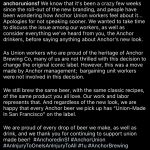 Revisiting that tiny part of my mind we discussed the other week, the bit that recalls that Anchor changed its branding, it’s interesting to see that that the brewery’s union is not happy and made it clear-ish on their Instagram account. And while “…many of us are not thrilled…” isn’t exactly a lyric from a Woody Guthrie song still makes the point. More not blah than blah. But overall, still a bit blah.
Revisiting that tiny part of my mind we discussed the other week, the bit that recalls that Anchor changed its branding, it’s interesting to see that that the brewery’s union is not happy and made it clear-ish on their Instagram account. And while “…many of us are not thrilled…” isn’t exactly a lyric from a Woody Guthrie song still makes the point. More not blah than blah. But overall, still a bit blah.
Further afield, Kenya is considering banning the quart, the preferred measure of youth and Cape Breton barroom brawls of the mid-1960s:
“We believe this is an outrageous, retrogressive proposal that has no place in our developing economy today and we are opposed to the proposals in the Bill,” Gordon Mutugi, ABAK chairman, said. The association argues the elimination of the option to sell alcohol packed in smaller packages would force those who cannot affordable quality alcoholic beverages sold in larger packaging to seek illicit and unhealthy alternatives. These include the purchase of alcohol in bulk and sharing it into smaller containers or consuming contraband alcohol from neighbouring countries.
Garth fears change. You know, that seems all a bit real. It’s been almost a year since me myself I saw actual real. Hmm… And I am not sure that I want to suggest Jeff shared a blah – but revisiting “craft” has been done by too many:
Craft brewing didn’t start becoming a real player for another decade—thirty years after its birth. And even then, it was making slow inroads into the fuller market. Only by the mid-teens had it achieved real substance, with 12% market share—though more important to an industry, it was earning more than one in five dollars of revenue.
Sure it’s just a label, a brand as much as Anchor’s only was… is… But, see, we are aware of these things but really the order is: (i) micro brewing (1980-2007ish), (ii) craft (2007-2015ish) and (iii) post-craft chaos (2015-now.) It is not analytically satisfying to backdate an era or delay its passing. Sure, I don’t really mind it as a unsubtle umbrella term, I suppose. But “craft” has been dead now coming on six years. Actual punk rock comes and goes in less time. It’s time to figure out what is going on now. What is it?
Relatedly, Toronto’s… err… Canada’s other national newspaper, the National Post also attempted to explain craft beer in the post craft chaos era including a description of the work of Lex Konnelly, a PhD candidate in the University of Toronto’s Department of Linguistics:
Beer has shifted from a working-class beverage to elite commodity, Konnelly explains in their paper recently published in the academic journal Language Communication. By speaking the language of so-called beer snobs, brutoglossia (“craft beer talk”) can perpetuate inequalities. Taste is far from arbitrary. It’s wrapped up in social status, which is in turn influenced by other categories such as gender and racial identity. Language is one of the ways people define the in-group and out-group.
Oh dear. What to make of it all? Comparing today’s clever lowest common denominator alcopops to an “elite commodity”?* Oh dear, oh dear. Then, similarly but far less so, “Flagship February” is hanging on but has shifted into a more general thing, another blog under a bushel like all those other blogs pushed out on the unsuspecting, feigning under any other name but blog. Yet… and yet… Stan sets aside any resulting potential for blah with his profile of a place called Halfway Crooks he posted on the FF blog:
Before Halfway Crooks Beer even opened their taproom in July 2019, they sold through their first run of hats with the words “LAGER LAGER LAGER LAGER” serving as a billboard. However, it would have been a mistake for beer drinkers walking around Atlanta proudly showing off this new hat to think this would be a lager-dominant brewery.
And, for the double,** Stan also gave us his thoughts on the effect of the US West Coast fires of 2020 on the hop crop:
…this is bad news for farmers affected because it reduces the value of some of their crop. But brewers should be aware that tainted hops could make their way into the supply chain. As one grower told me, “Here’s hoping we don’t see a rush of rauchbier’s coming into the market.” Unlike many people, I like rauchbiers, but I’m not looking forward to being surprised by a juicy IPA that tastes like licking an ash tray. (“Licking an ashtray” being a phrase used to describe wines made with smoke-tainted grapes.)
Blah beer but not a blah story. Not at all. And for maximum not-blah we have a post from Rye’s own pubman in hiding, Stonch sharing his fabulous style:
I drank a can of strong-as-fuck beer a couple of weeks ago, tweeted about it, and promised to review it here. One person has since asked me why I didn’t. In the face of such overwhelming demand, I must deliver. I can’t be bothered to match the pithy and succinct style I’d developed when this semi-dormant website was in its pomp, so you’ll have to plough through some verbose bullshit.
Finally – and as if just to prove they are not merely Egyptologists- the BBC tells us the latest calamitous news of the UK pub trade according to the British Beer and Pub Association (BBPA):
The BBPA said trading restrictions and lockdowns knocked sales by 56% – worth £7.8bn – last year. In the first lockdown in the second quarter of the year, beer sales plummeted by 96%, it said. Even during the summer, which saw the Eat Out to Help Out scheme and a temporary VAT cut on food and soft drinks, pub beer sales fell 27%.
Wow. Not blah. Yikes. Except things were locked. So it might be more odd that it was not 100%. Who was that 4%. We all now pray to Dr. Fauci and the gods of global distribution systems. Eleven months and in we know its closer to the end than the beginning. We know.
Do it! And while you are, for more good reading, check out the weekly updates from Boak and Bailey, back now mostly every Saturday, plus more at the OCBG Podcast on Tuesday (Jordan flips out over beer cocktails this week!) and sometimes on a Friday posts at The Fizz as well. We have a new entry from the DaftAboutCraft podcast. And sign up for Katie’s weekly newsletter, The Gulp, too. Plus the venerable Full Pint podcast. And Fermentation Radio with Emma Inch. There’s the AfroBeerChick podcast as well! And also look at Brewsround and Cabin Fever. And Ben has his own podcast, Beer and Badword (featuring another one of his irregular 1970s-esque TV dramedy season finale. Finaleissimmo!!!) And remember BeerEdge, too.
*The elite are actually drinking pre-mixed Clamato out of cans.
**Say “pour le double!!” like you are Charles de Gaulle speaking to Quebec in the 1960s!


